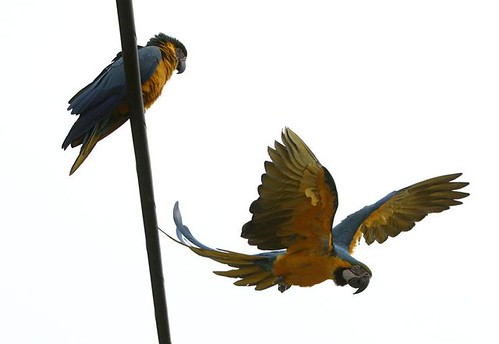Macaws spotted in Springfield subdivision
 Monday, March 9, 2009 at 12:00
Monday, March 9, 2009 at 12:00  The less shy macaw decides to fly down to the birdfeeder for the first time. Image by Shannon KirshnerTropical birds may have belonged to Carlinville enthusiast, experts say
The less shy macaw decides to fly down to the birdfeeder for the first time. Image by Shannon KirshnerTropical birds may have belonged to Carlinville enthusiast, experts say
Since Friday morning, residents on far-south-side Goodwin Court have noticed a pair of blue-and-gold macaws perching on telephone wires and trees lining the street.
The birds arrive shortly after dawn and disappear behind the Michael Von Behren Builders building, 3537 S. Douglas Ave., just before dusk.
Why the tropical, woodland-dwelling birds have made their home in the subdivision is anyone’s guess, but local bird experts believe they may have survived a trek from Carlinville to Springfield.
Carlinville bird enthusiast Del Nejmanowski died in August last year, leaving behind two macaw parrots from a flock that once numbered eight. Since his death, Nejmanowski’s family has not been able to track down the pair.
Local bird enthusiasts Kim Geving and Vera Herst say they think the macaws perched in front of Von Behren’s building may be the ones Nejmanowski once owned.
“When he passed away, nobody knew what happened to the birds,” Geving said.
If the birds did belong to Nejmanowski, they’re no strangers to Springfield.
The parrots used to fly along with their owner’s pickup when he drove to Springfield or to the McDonald’s in Carlinville. Experts say parrots imprint on locations as well as people, which explains why they kept coming back to Nejmanowski’s old neighborhood, even though the house where he lived was bulldozed more than two years ago.
Wherever they came from, the two Springfield macaws are homeless at the moment.
The Henson Robinson Zoo won’t take them in for fear they might be diseased, Von Behren said. But with the help of Geving and Herst, Von Behren built a bird feeder for the macaws Monday afternoon.
“I just came out this morning and noticed those macaws were on the wire,” Von Behren said. “I called some people who really know about birds, and they came here to tell us how to take care of them and how to feed them.”
Food alone may not be sufficient to keep the birds alive. The birds are missing toes, an indication that they may have recently suffered from frostbite, according to Herst.
Whether they can survive another spell of cold weather is another matter.
 Ara ararauna - Blue-and-Gold Macaw | in
Ara ararauna - Blue-and-Gold Macaw | in  Urban parrots
Urban parrots 
